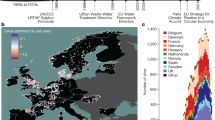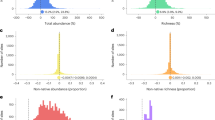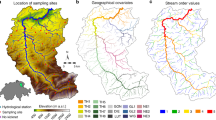Abstract
Humans impact terrestrial, marine and freshwater ecosystems, yet many broad-scale studies have found no systematic, negative biodiversity changes (for example, decreasing abundance or taxon richness). Here we show that mixed biodiversity responses may arise because community metrics show variable responses to anthropogenic impacts across broad spatial scales. We first quantified temporal trends in anthropogenic impacts for 1,365 riverine invertebrate communities from 23 European countries, based on similarity to least-impacted reference communities. Reference comparisons provide necessary, but often missing, baselines for evaluating whether communities are negatively impacted or have improved (less or more similar, respectively). We then determined whether changing impacts were consistently reflected in metrics of community abundance, taxon richness, evenness and composition. Invertebrate communities improved, that is, became more similar to reference conditions, from 1992 until the 2010s, after which improvements plateaued. Improvements were generally reflected by higher taxon richness, providing evidence that certain community metrics can broadly indicate anthropogenic impacts. However, richness responses were highly variable among sites, and we found no consistent responses in community abundance, evenness or composition. These findings suggest that, without sufficient data and careful metric selection, many common community metrics cannot reliably reflect anthropogenic impacts, helping explain the prevalence of mixed biodiversity trends.
This is a preview of subscription content, access via your institution
Access options
Access Nature and 54 other Nature Portfolio journals
Get Nature+, our best-value online-access subscription
$29.99 / 30 days
cancel any time
Subscribe to this journal
Receive 12 digital issues and online access to articles
$119.00 per year
only $9.92 per issue
Buy this article
- Purchase on Springer Link
- Instant access to full article PDF
Prices may be subject to local taxes which are calculated during checkout






Similar content being viewed by others
Data availability
All community metrics, biomonitoring indices and ecological quality data needed to reproduce our analyses are publicly available from Figshare at https://doi.org/10.6084/m9.figshare.24486769.
Code availability
All code used for our analyses is available upon request.
References
Barnosky, A. D. et al. Has the Earth’s sixth mass extinction already arrived? Nature 471, 51–57 (2011).
Ceballos, G. et al. Accelerated modern human-induced species losses: entering the sixth mass extinction. Sci. Adv. 1, e1400253 (2015).
Yasuhara, M., Hunt, G., Breitburg, D., Tsujimoto, A. & Katsuki, K. Human-induced marine ecological degradation: micropaleontological perspectives. Ecol. Evol. 2, 3242–3268 (2012).
Newbold, T. et al. Global effects of land use on local terrestrial biodiversity. Nature 520, 45–50 (2015).
Reid, A. J. et al. Emerging threats and persistent conservation challenges for freshwater biodiversity. Biol. Rev. 94, 849–873 (2019).
Tickner, D. et al. Bending the curve of global freshwater biodiversity loss: an emergency recovery plan. BioScience 70, 330–342 (2020).
Vellend, M. et al. Global meta-analysis reveals no net change in local-scale plant biodiversity over time. Proc. Natl Acad. Sci. USA 110, 19456–19459 (2013).
Dornelas, M. et al. Assemblage time series reveal biodiversity change but not systematic loss. Science 344, 296–299 (2014).
Blowes, S. A. et al. The geography of biodiversity change in marine and terrestrial assemblages. Science 366, 339–345 (2019).
Millette, K. L. et al. No consistent effects of humans on animal genetic diversity worldwide. Ecol. Lett. 23, 55–67 (2020).
Pilotto, F. et al. Meta-analysis of multidecadal biodiversity trends in Europe. Nat. Commun. 11, 3486 (2020).
van Klink, R. et al. Meta-analysis reveals declines in terrestrial but increases in freshwater insect abundances. Science 368, 417–420 (2020).
Outhwaite, C. L., Gregory, R. D., Chandler, R. E., Collen, B. & Isaac, N. J. B. Complex long-term biodiversity change among invertebrates, bryophytes and lichens. Nat. Ecol. Evol. 4, 384–392 (2020).
Wagner, D. L., Fox, R., Salcido, D. M. & Dyer, L. A. A window to the world of global insect declines: moth biodiversity trends are complex and heterogeneous. Proc. Natl Acad. Sci. USA 118, e2002549117 (2021).
Carvalheiro, L. G. et al. Species richness declines and biotic homogenisation have slowed down for NW-European pollinators and plants. Ecol. Lett. 16, 870–878 (2013).
Schipper, A. M. et al. Contrasting changes in the abundance and diversity of North American bird assemblages from 1971 to 2010. Glob. Change Biol. 22, 3948–3959 (2016).
Hallmann, C. A. et al. More than 75 percent decline over 27 years in total flying insect biomass in protected areas. PLoS ONE 12, e0185809 (2017).
Haase, P. et al. The recovery of European freshwater biodiversity has come to a halt. Nature 620, 582–588 (2023).
de los Santos, C. B. et al. Recent trend reversal for declining European seagrass meadows. Nat. Commun. 10, 3356 (2019).
Kuczynski, L., Ontiveros, V. J. & Hillebrand, H. Biodiversity time series are biased towards increasing species richness in changing environments. Nat. Ecol. Evol. 7, 994–1001 (2023).
Gonzalez, A. et al. Estimating local biodiversity change: a critique of papers claiming no net loss of local diversity. Ecology 97, 1949–1960 (2016).
Cardinale, B. J., Gonzalez, A., Allington, G. R. H. & Loreau, M. Is local biodiversity declining or not? A summary of the debate over analysis of species richness time trends. Biol. Conserv. 219, 175–183 (2018).
Valdez, J. W. et al. The undetectability of global biodiversity trends using local species richness. Ecography 2023, e06604 (2023).
Catford, J. A., Wilson, J. R. U., Pyšek, P., Hulme, P. E. & Duncan, R. P. Addressing context dependence in ecology. Trends Ecol. Evol. 37, 158–170 (2022).
Elahi, R. et al. Recent trends in local-scale marine biodiversity reflect community structure and human impacts. Curr. Biol. 25, 1938–1943 (2015).
Hillebrand, H. et al. Biodiversity change is uncoupled from species richness trends: consequences for conservation and monitoring. J. Appl. Ecol. 55, 169–184 (2018).
Ludsin, S. A., Kershner, M. W., Blocksom, K. A., Knight, R. L. & Stein, R. A. Life after death in Lake Erie: nutrient controls drive fish species richness, rehabilitation. Ecol. Appl. 11, 731–746 (2001).
Fournier, A. M. V., White, E. R. & Heard, S. B. Site-selection bias and apparent population declines in long-term studies. Conserv. Biol. 33, 1370–1379 (2019).
Magurran, A. E. et al. Long-term datasets in biodiversity research and monitoring: assessing change in ecological communities through time. Trends Ecol. Evol. 25, 574–582 (2010).
Bonada, N., Prat, N., Resh, V. H. & Statzner, B. Developments in aquatic insect biomonitoring: a comparative analysis of recent approaches. Annu. Rev. Entomol. 51, 495–523 (2006).
Pharaoh, E., Diamond, M., Ormerod, S. J., Rutt, G. & Vaughan, I. P. Evidence of biological recovery from gross pollution in English and Welsh rivers over three decades. Sci. Total Environ. 878, 163107 (2023).
Water Framework Directive (WFD). Directive 2000/60/EC of the European Parliament and of the Council of 23 October 2000 establishing a framework for community action in the field of water policy. Off. J. Eur. Comm. 327, 1–72 (2000).
Birk, S. et al. Three hundred ways to assess Europe’s surface waters: an almost complete overview of biological methods to implement the Water Framework Directive. Ecol. Indic. 18, 31–41 (2012).
Bennett, C. et al. Bringing European river quality into line: an exercise to intercalibrate macro-invertebrate classification methods. Hydrobiologia 667, 31–48 (2011).
Desquilbet, M. et al. Comment on ‘Meta-analysis reveals declines in terrestrial but increases in freshwater insect abundances. Science 370, eabd8947 (2020).
Giakoumis, T. & Voulvoulis, N. The transition of EU water policy towards the Water Framework Directive’s Integrated River Basin Management Paradigm. Environ. Manage. 62, 819–831 (2018).
The European Environment—State and Outlook 2020 (European Environment Agency, 2020); https://www.eea.europa.eu/soer/publications/soer-2020
Gozlan, R. E., Karimov, B. K., Zadereev, E., Kuznetsova, D. & Brucet, S. Status, trends, and future dynamics of freshwater ecosystems in Europe and Central Asia. Inland Waters 9, 78–94 (2019).
O’Briain, R. Climate change and European rivers: an eco-hydromorphological perspective. Ecohydrology 12, e2099 (2019).
Wolfram, J., Stehle, S., Bub, S., Petschick, L. L. & Schulz, R. Water quality and ecological risks in European surface waters—monitoring improves while water quality decreases. Environ. Int. 152, 106479 (2021).
Bernhardt, E. S., Rosi, E. J. & Gessner, M. O. Synthetic chemicals as agents of global change. Front. Ecol. Environ. 15, 84–90 (2017).
Pereira, H. M. et al. Essential biodiversity variables. Science 339, 277–278 (2013).
Deiner, K. et al. Environmental DNA metabarcoding: transforming how we survey animal and plant communities. Mol. Ecol. 26, 5872–5895 (2017).
Anderson, C. B. Biodiversity monitoring, earth observations and the ecology of scale. Ecol. Lett. 21, 1572–1585 (2018).
Miller, S. W., Budy, P. & Schmidt, J. C. Quantifying macroinvertebrate responses to in-stream habitat restoration: applications of meta-analysis to river restoration. Restor. Ecol. 18, 8–19 (2010).
Ferreira, W. R. et al. Importance of environmental factors for the richness and distribution of benthic macroinvertebrates in tropical headwater streams. Freshw. Sci. 33, 860–871 (2014).
Hodgson, J. A., Thomas, C. D., Wintle, B. A. & Moilanen, A. Climate change, connectivity and conservation decision making: back to basics. J. Appl. Ecol. 46, 964–969 (2009).
Mortelliti, A., Amori, G. & Boitani, L. The role of habitat quality in fragmented landscapes: a conceptual overview and prospectus for future research. Oecologia 163, 535–547 (2010).
Crossley, M. S. et al. No net insect abundance and diversity declines across US Long Term Ecological Research sites. Nat. Ecol. Evol. 4, 1368–1376 (2020).
Johnson, R. K. & Hering, D. Spatial congruency of benthic diatom, invertebrate, macrophyte, and fish assemblages in European streams. Ecol. Appl. 20, 978–992 (2010).
Vellend, M. The biodiversity conservation paradox. Am. Sci. 105, 94–101 (2017).
Dornelas, M. et al. A balance of winners and losers in the Anthropocene. Ecol. Lett. 22, 847–854 (2019).
Heino, J. et al. Metacommunity organisation, spatial extent and dispersal in aquatic systems: patterns, processes and prospects. Freshw. Biol. 60, 845–869 (2015).
Heino, J. The importance of metacommunity ecology for environmental assessment research in the freshwater realm. Biol. Rev. 88, 166–178 (2013).
Ruaro, R., Gubiani, É. A., Hughes, R. M. & Mormul, R. P. Global trends and challenges in multimetric indices of biological condition. Ecol. Indic. 110, 105862 (2020).
Hawkins, C. P. Quantifying biological integrity by taxonomic completeness: its utility in regional and global assessments. Ecol. Appl. 16, 1277–1294 (2006).
Vandewalle, M. et al. Functional traits as indicators of biodiversity response to land use changes across ecosystems and organisms. Biodivers. Conserv. 19, 2921–2947 (2010).
Miraldo, A. et al. An Anthropocene map of genetic diversity. Science 353, 1532–1535 (2016).
Violle, C., Reich, P. B., Pacala, S. W., Enquist, B. J. & Kattge, J. The emergence and promise of functional biogeography. Proc. Natl Acad. Sci. USA 111, 13690–13696 (2014).
Maureaud, A. et al. Biodiversity–ecosystem functioning relationships in fish communities: biomass is related to evenness and the environment, not to species richness. Proc. R. Soc. B 286, 20191189 (2019).
Jarzyna, M. A. & Jetz, W. Taxonomic and functional diversity change is scale dependent. Nat. Commun. 9, 2565 (2018).
Pielou, E. C. The measurement of diversity in different types of biological collections. J. Theor. Biol. 13, 131–144 (1966).
Spellerberg, I. F. & Fedor, P. J. A tribute to Claude Shannon (1916–2001) and a plea for more rigorous use of species richness, species diversity and the ‘Shannon–Wiener’ Index. Glob. Ecol. Biogeogr. 12, 177–179 (2003).
Haase, P. et al. Moderate warming over the past 25 years has already reorganized stream invertebrate communities.Sci. Total Environ. 658, 1531–1538 (2019).
Vitecek, S., Johnson, R. K. & Poikane, S. Assessing the ecological status of European rivers and lakes using benthic invertebrate communities: a practical catalogue of metrics and methods. Water 13, 346 (2021).
R Core Team. R: A Language and Environment for Statistical Computing (2022); https://www.r-project.org
Huber, P. J. Robust Statistical Procedures 2nd edn (SIAM, 1996).
EuroGeographics. Countries—Administrative Units (2020); https://ec.europa.eu/eurostat/web/gisco/geodata/reference-data/administrative-units-statistical-units/countries
Acknowledgements
We thank J. England for assistance with calculating ecological quality and the biomonitoring indices in the UK. Funding for authors, data collection and processing was provided by the European Union Horizon 2020 project eLTER PLUS (grant number 871128). F.A. was supported by the Swiss National Science Foundation (grant numbers 310030_197410 and 31003A_173074) and the University of Zurich Research Priority Program Global Change and Biodiversity. J.B. and M.A.-C. were funded by the European Commission, under the L‘Instrument Financier pour l’Environnement (LIFE) Nature and Biodiversity program, as part of the project LIFE-DIVAQUA (LIFE18 NAT/ES/000121) and also by the project ‘WATERLANDS’ (PID2019-107085RB-I00) funded by the Ministerio de Ciencia, Innovación y Universidades (MCIN) and Agencia Estatal de Investigación (AEI; MCIN/AEI/10.13039/501100011033/ and by the European Regional Development Fund (ERDF) ‘A way of making Europe’. N.J.B. and V.P. were supported by the Lithuanian Environmental Protection Agency (https://aaa.lrv.lt/) who collected the data and were funded by the Lithuanian Research Council (project number S-PD-22-72). J.H. was supported by the Academy of Finland (grant number 331957). S.C.J. acknowledges funding by the Leibniz Competition project Freshwater Megafauna Futures and the German Federal Ministry of Education and Research (Bundesministerium für Bildung und Forschung or BMBF; 033W034A). A.L. acknowledges funding by the Spanish Ministry of Science and Innovation (PID2020-115830GB-100). P.P., M.P. and M.S. were supported by the Czech Science Foundation (GA23-05268S and P505-20-17305S) and thank the Czech Hydrometeorological Institute and the state enterprises Povodí for the data used to calculate ecological quality metrics from the Czech surface water monitoring program. H.T. was supported by the Estonian Research Council (number PRG1266) and by the Estonian national program ‘Humanitarian and natural science collections’. M.J.F. acknowledges the support of Fundação para a Ciência e Tecnologia, Portugal, through the projects UIDB/04292/2020 and UIDP/04292/2020 granted to the Marine and Environmental Sciences Centre, LA/P/0069/2020 granted to the Associate Laboratory Aquatic Research Network (ARNET), and a Call Estímulo ao Emprego Científico (CEEC) contract.
Author information
Authors and Affiliations
Contributions
J.S.S. and P.H. conceived the study. E.A.R.W. cleaned the data, and J.S.S. performed the analyses. J.S.S. and P.H. wrote the majority of the manuscript. F.A., M.A.-C., J.A., N.J.B., L. Barešová, J.B., L. Bonacina, N.B., M.C.-A., Z.C., E.d.E., A.D., G.D., T.E.E., V.E., M.J.F., M. Ferréol, M. Floury, M.A.E.F., R.F., P.L.M.G., J.H., D.H., K.-L.H., S.C.J., R.K.J., L.K., B.K., L.L., A.L., P.L., A.W.L., B.G.M., T.M., D.O., R.P., V.P., P.P., F.P., M.P., J.J.R., R.B.S., A.S.-K., A. Scotti, A. Skuja, M.S., R.S., H.T., V.T., I.T., R.V., G. Várbíró, G. Velle, R.C.M.V. and S.V. provided invertebrate data or contributed to calculating ecological quality values for their respective countries, and all edited the manuscript.
Corresponding author
Ethics declarations
Competing interests
A. Scotti is affiliated with APEM, which is an environmental consultancy company, although they provided no funding for this study. The other authors declare no competing interests.
Peer review
Peer review information
Nature Ecology & Evolution thanks Steve Ormerod, Adam Yates and the other, anonymous, reviewer(s) for their contribution to the peer review of this work. Peer reviewer reports are available.
Additional information
Publisher’s note Springer Nature remains neutral with regard to jurisdictional claims in published maps and institutional affiliations.
Extended data
Extended Data Fig. 1 Year-to-year changes in ecological quality.
Differences in the predicted (a) EQRs and (b) EQCs between each year and the previous year during 1993–2019. For example, the 1993 values are the absolute differences in the predicted EQRs/EQCs between 1992 and 1993. Thus, values closer to 0 indicate less change between successive years. Predicted values for the EQRs and EQCs were obtained from their respective generalized additive mixed models (that is, the fitted relationships in Fig. 2).
Extended Data Fig. 2 Country-scale links between ecological quality, community metrics, and biomonitoring indices.
Redundancy Analyses (RDAs) of the relationship between the Ecological Quality Ratios (EQRs; black arrows) and the community metrics and biomonitoring indices for (a) Finland (FI), (b) Ireland (IE), (c) Luxembourg (LU), (d) Norway (NO), and (e) the United Kingdom (UK). The community metrics comprise abundance (Nind), richness (Ntaxa), evenness (EvPie), Shannon diversity (H), and temporal turnover between consecutive years (TurnY) and compared to the first year (Turn1). The biomonitoring indices comprise the total abundance (EPTind), proportion (EPT%), and richness (EPTtaxa) of Ephemeroptera, Plecoptera, and Trichoptera, in addition to the Community Temperature Index (CTI), the proportion of littoral taxa (Plit), and the Rhithron feeding type index (RETI; all indices are described in the Methods and Extended Data Table 1). Metrics and indices are coloured from orange to blue based on their loadings on RDA axis 1, with blues indicating stronger relationships to ecological quality.
Extended Data Fig. 3 Site-scale links between ecological quality and biomonitoring indices.
Relationship between the temporal slope of the Ecological Quality Ratio (EQR) at each site and the slope of (a) the richness of Ephemeroptera, Plecoptera, and Trichoptera (EPTtaxa), (b) EPT abundance (EPTind), (c) the proportion of EPT taxa (EPT%), (d) the Average Score Per Taxon (ASPT) index, (e) the Community Temperature Index (CTI), (f) the proportion of littoral taxa (Plit), (g) the Saprobic Index (SI), and (h) the Rhithron feeding type index (RETI). Sites are coloured by country and sites with matching ecological quality and biodiversity trends are in the gray shaded areas, whereas opposing relationships are in the white areas.
Supplementary information
Supplementary Information
Supplementary Tables 1–4 and Supplementary Figs. 1–9.
Rights and permissions
Springer Nature or its licensor (e.g. a society or other partner) holds exclusive rights to this article under a publishing agreement with the author(s) or other rightsholder(s); author self-archiving of the accepted manuscript version of this article is solely governed by the terms of such publishing agreement and applicable law.
About this article
Cite this article
Sinclair, J.S., Welti, E.A.R., Altermatt, F. et al. Multi-decadal improvements in the ecological quality of European rivers are not consistently reflected in biodiversity metrics. Nat Ecol Evol 8, 430–441 (2024). https://doi.org/10.1038/s41559-023-02305-4
Received:
Accepted:
Published:
Issue Date:
DOI: https://doi.org/10.1038/s41559-023-02305-4
This article is cited by
-
Are long-term biomonitoring efforts overlooking crayfish in European rivers?
Environmental Sciences Europe (2024)



